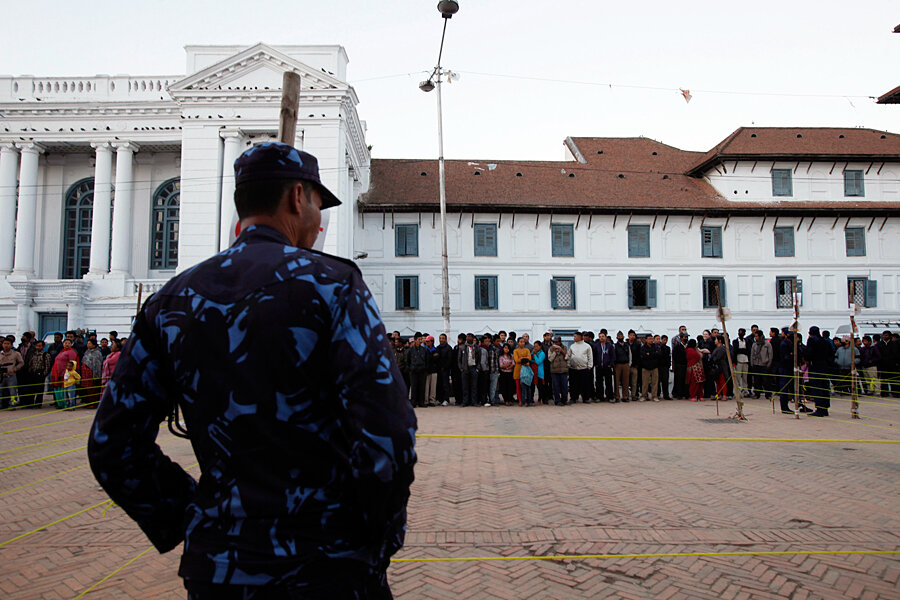Nepal sees record turnout as voters seek path out of stalemate
Loading...
| Kathmandu, Nepal
Polling stations were packed in Nepal early Tuesday morning as voters, deciding that casting ballots would be their first duty of the day, queued up – some for hours – to elect the country’s second constituent assembly in six years.
Even as people packed voting locales, the government took unprecedented security measures, mobilizing more than 170,000 security personnel including soldiers, police, and armed police. The streets in the capital of Kathmandu stood empty save for security patrols and vehicles carrying election observers and the media. Alcohol sale and consumption was banned, and voters were required to switch off cellphones before entering polling stations.
The precautions proved a bonanza for children, who took to the city's wide-open thoroughfares to play cricket, badminton, and roller skates. Adults, for their part, enjoyed a rare day of uninterrupted power supply thanks to the government’s decision to suspend power rationing.
At day's end, the measures appeared to have succeeded: Despite violence by a radical Maoist group in the run-up to the election that left one dead and dozens injured, voting was mostly peaceful, barring one blast near a polling station in Kathmandu in which an eight-year-old boy was injured, police spokesman Ganesh K.C. said. Some minor clashes were also reported at polling stations outside Kathmandu.
The Election Commission said voter turnout was more than 70 percent on a national average. About 12 million voters were eligible to cast two votes – one direct vote for electing 240 legislators and another proportional vote for the party of their choice.
"This is the highest ever turnout in the country's general elections," said Nilkantha Uprety, chief election commissioner.
Final results for the 240 seats are expected to take about a week, while the results of 335 proportional seats – to be divided among political parties based on the percentage of votes they get – are expected to take longer. An additional 26 legislators in the 601-member assembly will be nominated by a new government.
More than 100 parties participated in the election. Their election symbols ranged from the familiar sickle and hammer, or tree and sun of major parties, to the umbrella, key, house, scissors, and even slippers of lesser-known parties.
The assembly will be tasked with finalizing a new constitution, one of the twin demands of Nepal’s Maoists who waged a 10-year armed insurgency until 2006, also demanding a republic. The insurgency left over 17,000 dead, according to official figures.
For more on what's at stake for Nepal, read 'Nepal's tumult drives new pragmatism'
A previous assembly elected in 2008 abolished a 240-year old monarchy but failed to draw up a constitution because of irreconcilable differences over the basis for federating this tiny Himalayan nation, which has 125 ethnic groups and 123 languages. The assembly was dissolved in May last year, plunging the country into a political vacuum.
Like last time, the country is again expected to elect a fractured assembly with no party commanding a majority. Some fear the power games that dominated the last assembly, overshadowing its legitimate agendas, could resume after the results are out.
Nepal has had four governments led by political parties since 2008, each of which failed to conclude a post-monarchy transition. A fifth government was formed in March this year for holding elections. The provisional government is headed by the country’s Chief Justice whose Cabinet is composed of retired senior bureaucrats.
The Unified Communist Party of Nepal (Maoist) that commanded the most seats in the previous assembly is widely expected to lose seats this time, principally because of a split in the party last year. The breakaway group of radicals boycotted the election. But the Maoists, Nepali Congress, and Communist Party of Nepal (Unified Marxist Leninist) are again expected to be the three biggest parties.
The Rastriya Prajatantra Party-Nepal, a pro-monarchy and pro-Hindu party that had just four seats in the last assembly, is expected to benefit from popular disillusionment with major parties and also from the country’s 80 percent Hindus, sections of which find the party’s call for reverting the country from secular to Hindu state appealing.







